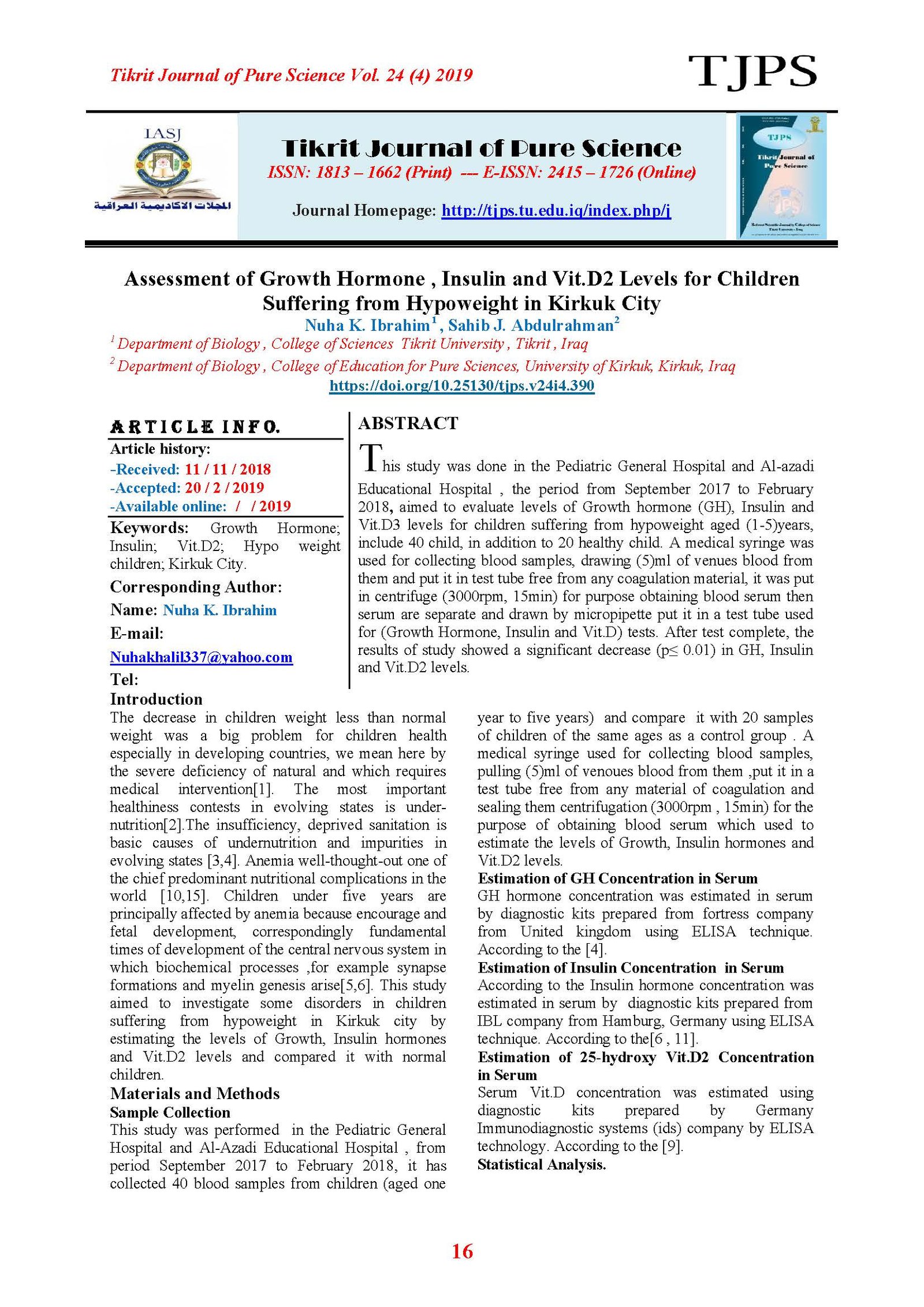Assessment of Growth Hormone , Insulin and Vit.D2 Levels for Children Suffering from Hypoweight in Kirkuk City
Main Article Content
Abstract
This study was done in the Pediatric General Hospital and Al-azadi Educational Hospital , the period from September 2017 to February 2018, aimed to evaluate levels of Growth hormone (GH), Insulin and Vit.D3 levels for children suffering from hypoweight aged (1-5)years, include 40 child, in addition to 20 healthy child. A medical syringe was used for collecting blood samples, drawing (5)ml of venues blood from them and put it in test tube free from any coagulation material, it was put in centrifuge (3000rpm, 15min) for purpose obtaining blood serum then serum are separate and drawn by micropipette put it in a test tube used for (Growth Hormone, Insulin and Vit.D) tests. After test complete, the results of study showed a significant decrease (p≤ 0.01) in GH, Insulin and Vit.D2 levels.
Article Details

This work is licensed under a Creative Commons Attribution 4.0 International License.
Tikrit Journal of Pure Science is licensed under the Creative Commons Attribution 4.0 International License, which allows users to copy, create extracts, abstracts, and new works from the article, alter and revise the article, and make commercial use of the article (including reuse and/or resale of the article by commercial entities), provided the user gives appropriate credit (with a link to the formal publication through the relevant DOI), provides a link to the license, indicates if changes were made, and the licensor is not represented as endorsing the use made of the work. The authors hold the copyright for their published work on the Tikrit J. Pure Sci. website, while Tikrit J. Pure Sci. is responsible for appreciate citation of their work, which is released under CC-BY-4.0, enabling the unrestricted use, distribution, and reproduction of an article in any medium, provided that the original work is properly cited.
References
[1] Awad, H.R. (2015). Weight losing during birth and psychological problem follow in life. Mid. west. j ,52(1):1-5.
[2] Adias, T.C.; Igwilo, A.C.; Jeremiah and Z.A.(2012). Repeat whole blood donation correlates significantly with reductions in BMI and lipid profiles and increased gamma glutamic transferase (GGT) activity among Nigerian blood donors 4;85-90.
[3] Anthony, P. F.; Chen, Z.; Chen, and Sergey, A. (2009): In vitro diagnostics in diabetes. Meeting the challenge. Clin. Chem., 45(9):1596- 1601.
[4] Al-Allan, A.; Sundararajan, K. ; Majid, S. A.; Najee, J. A.; Amal, A.; Iman, S.; Naima, M. A.; Mona, F.; Iqbal, Z. T. and Nasser, M. (2015). Vitamin D deficiency and dyslipidemia in early pregnancy. J. of Pregnant women,15:314-322.
[5] Bishop, M.,; Kirk, J.and fody, E.(2000). Clinical chemistry 4thed. Lippincot Williams and Wilkins, Philadelphia, USA,12 220-221.
[6] Chukwurah, E.F. and Nneli, R.O. (2005). Prevalence of transfusion transmissible infection disease markers among blood donors in a south Eastern state of Nigeria, Nigeria Biomedical Science Journal. International Journal of Blood transfusion and Immunohematology, 7 (43):97-114.
[7] Ferreira, T. S. ; Tatiana, M. R.; Marcie, R. and Antonio, F.S. (2015). Vitamin D deficiency is associated with insulin resistance independent of intracellular calcium, dietary calcium and serum levels of parathyroid hormone, calcitriol and calcium in premenopausal women. J. Nutr Hosp., 31(4):1491-1498
[8] Frier, B. M., Ashby, J. P.; Nairn, I. M. and Bairs, J.D. (1981). Plasma insulin, C-peptide and glucagon concentrations in patients with insulin-independent diabetes treated with chlorpropamide, Res. j. of Diab. metab.,7(1):45-49.
[9] Gallagher, J.C.; Jindal, P.S. and Smith, L.M. (2014). Vitamin D supplementation in young White and African American women. J. Bone Miner Res., 29(1):173-181.
[10] Gerard, J. ; Tortora, J. B. and Bryan, D. (2014). Metabolism and Nutrition. Principles of Anatomy and Physiology Valencia College 14thed., 25(5):927.
[11] Jianhua, S.; Naixue, C.; Guoping, Z.; Yuexian, A.; Guiju, S.; Sophie, R. Z. and Jianghong, L.(2016). Hemoglobin Status and Externalizing Behavioral Problems in Children. International Journal of Environmental Research and Public Health, 2:21-25.
[12] Judzewitsch, R. G. ; Pfeifer, M. A. ; Best, J. D. ; Beard, J. C. ; Halter, J. B. and Porte, D. J. (1982). Chronic Chlorpropamide therapy of noninsulin-dependent diabetes augments basal and stimulated insulin secretion by increasing islet sensitivity to glucose. J. Clin. End. and Metab. 55(2):321-328.
[13] Kapoor, M. (2001). Fluid and electrolyte abnormalities. J. Criti. Care Clin., 17(3): 503-529.
[14] Laurie,R.; Braun, R.; Marino,(2017). Disorders of Growth and Stature,:38(7):293-304.
[15] Maser R.; Steenkiste, A. and Dorman, J. ( 2008 ). Epidemiological correlates of diabetic neuropathy: report from Pittsburgh Epidemiology of Diabetes Complications Study. Diabetes;38:145-148.
[16] Murphy, EL, Schlumpf, K. and Wright, D.J.(2012). BMI and obesity in US blood donors: A potential public health role for the blood center. Public HealthNutr,961-964.
[17] Norman, A.W. and Henry, L. H.(2015). Hormones, 3rd edition. An extracellular glycoprotein involved in bone mineralization and insulin signaling. Proc. Natl. Acad. Sci. U.S.A,109:715-717.
